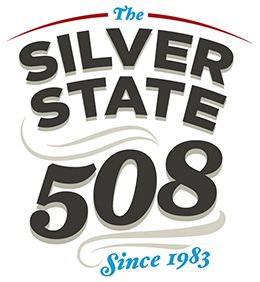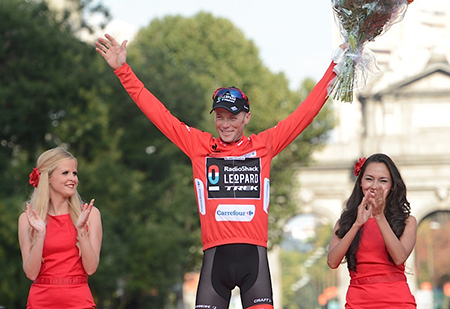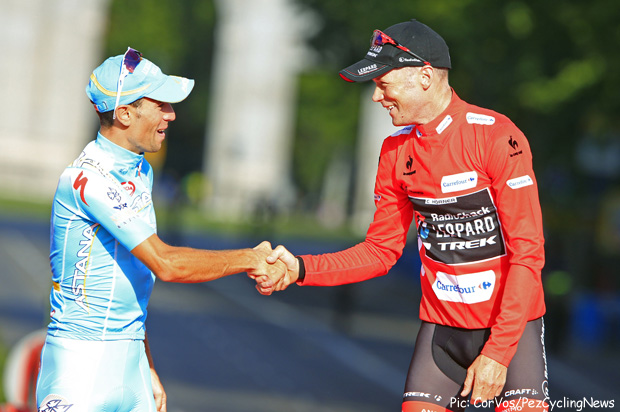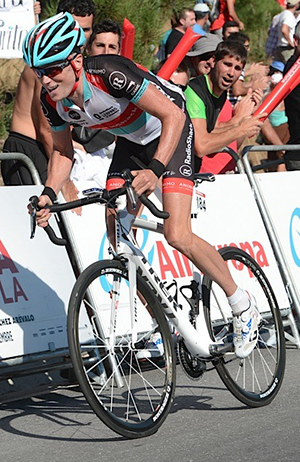
I have this theory regarding functional art, that if an object or piece of equipment is designed to perform its function correctly, it will appear pleasing to the eye from an aesthetic point of view. A piece of furniture like a chair, a bridge, a boat, or indeed a bicycle, all fall into this category of functional art.
Not only does the bicycle need to look right standing alone, but rider and bicycle need to look right together. The bicycle becomes an extension of the rider, a platform if you will for the athlete to launch a physical effort.
As a result of my last article, a story of the above track bike, the bike’s former owner, Maggie Thompson, formally Margaret Gordon Smith, commented on the piece, and sent me the above picture, of her actually racing on the track in the British National Women’s Pursuit Championships.
Rarely do I get to see a perfect side on photo of a rider and bike, where the rider is at maximum speed and one can see how well rider and bike fit together. For those who don’t know what Pursuit Racing is about? Two riders start on opposite sides of a banked track or Velodrome, and they chase each other. Hence the name Pursuit.
It is a race of truth, like a time trial, there is no pacing. The winner is the rider ahead at the end of a set distance. The women’s pursuit is 3,000 meters, which is 3 kilometers, or 1.863 miles. Not a huge distance, but one starts out about half a lap out of the saddle to reach maximum speed, then sit down and try to maintain that speed to the end. It is a race that will leave you gasping for breath for an agonizing 4 minutes.
Maggie describing this bike said, “I found I could breath.” That was because the rule of frame design back in the mid-1970s and before, was a 73 degree seat angle for everyone no matter how tall or how short. Maggie is slightly over 5’ 3” tall, which is not unusual. Many women are in the 5 foot to 5 foot 4 inch range.
This frame had a 77 degree seat angle which was unheard of at the time. But while 73 degrees is fine for a tall person with long legs, for the shorter rider it means the thighs are pressing tight into the upper torso thus restricting breathing. Of course it is essential the back be horizontal for maximum aerodynamic efficiency, and the steeper seat angle cuts down the angle of torso bent at the pelvis. It also allows for a shorter top tube meaning the rider is not stretched out, and the arms are working in opposition the legs.
 Right: Maggie on her road bike I also bult for her. This frame had a 76 degree seat angle.
Right: Maggie on her road bike I also bult for her. This frame had a 76 degree seat angle.
When it comes to designing and building bikes for women, it is not that women are drastically different proportionally than men, it is that they are generally a lot smaller.
It is a myth that all women have longer legs and shorter bodies.
Women come in all shapes and sizes the same as men, long legs short torso, short legs long torso.
The main difference being, shorter overall height and much smaller feet than men.
The length of the foot comes into play because when pedaling the toe is pointing down at the bottom of the pedal stroke, so the foot becomes an extension of the leg. A man and a woman of the same height and leg length could both use an identical frame, but the female rider would have her saddle set lower because of her smaller feet.
The problem frame designers and builders have always faced when it comes to building bikes for women, is in making bikes small enough. There is a limitation caused by the wheel size. In the last 60 or more years I have been involved with racing bikes, (And before.) they have had 27 inch wheels, the wheel diameter to the outside of the tire is 27 inch diameter, or slightly less depending on the tire cross section.
700C wheels are the same, 27 inch diameter or slightly less. I always thought the “C” was for Clincher, but I have noticed tubular tires are now also called 700C. A front fork has fork blades that are the same length no matter how large or small a frame is, because the front wheel is the same 27 inch diameter for all sizes.
Throughout the range of frame sizes, the fork crown stays in the same place. So does the bottom headset bearing, and in the days of lugged steel frames the bottom head lug was always in a constant position.
Everything above this point varies with the frame size. The length of the fork steering tube, the frame head tube, the top tube is higher, etc., etc. In the days when top tubes were always level, the framebuilder could only lower the top tube until the top head lug met the bottom head lug.
Metal could be removed from the top and bottom lugs but for all practical purposes the smallest frame one could build with a level top tube was 48 cm. (19 in. C to T) with a standard bottom bracket height. After that one could raise the bottom bracket to make the seat tube shorter, but the last thing a rider with short legs needs is to be higher from the ground.
Incidentally in the top picture, Maggie’s track frame is 19” but the head lugs are not touching. That is because track bikes have a higher bottom bracket to clear the angle of the track banking. Also the steeper than normal seat tube pushed the seat lug higher, and therefore the top tube.
Today’s frame design with the sloping top tube does make it possible to make much shorter seat tubes. However, the front end stays exactly where it has always been, because the front wheel is still the same diameter. The good news is, shorter riders do not need a huge difference in saddle to handlebar height. See how little difference there is in the top picture of Maggie on her bike.
My advice to a female cyclist who wishes to engage in serious competition. If you are 5’ 6” in height, or taller you can ride a men’s frame, bearing in mind what I said earlier about your saddle being lower because of your smaller feet. If you are shorter than 5‘ 6” and especially if you are in the 5 foot to 5’ 4” height range, get the smallest frame with the shortest top tube you can.
There are frames out there that are advertised as being Female Specific. These have a longer head tube resulting in a higher front end. There is less drop down from the saddle to the top of the handlebars, making for a more relaxed position. These are great if you just want to ride for exercise or engage in ultra-long distance rides. There are similar frames for men with names like “Endurance.”
Whether male or female, choose a bike or frame that suits your purpose. If you want to race seriously get a race bike and set it up in an efficient aerodynamic position. If your goal is exercise and more leisurely riding, don’t buy a race frame, buy one of the bikes offered for that purpose.

To Share click "Share Article" below
 Tue, April 4, 2017
Tue, April 4, 2017 





























